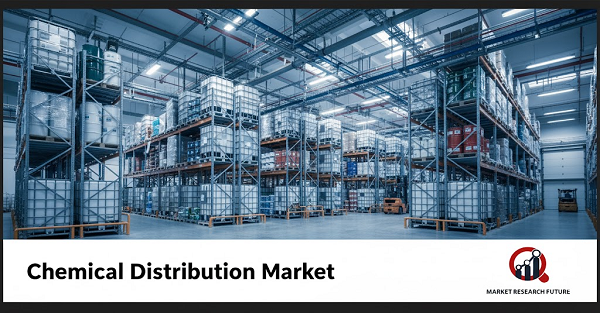
Chemical Distribution Market Overview
The chemical distribution market was valued at USD 272.76 billion in 2024 and is projected to reach USD 534.24 billion by 2035, growing at a CAGR of 6.30% from 2025 to 2035.
The market’s expansion is driven by increasing demand for both specialty and commodity chemicals across key end-use industries such as pharmaceuticals, construction, oil and gas, and automotive.
Rapid industrialization, the rise of global trade networks, and the need for efficient supply chain management are fueling market growth worldwide.
Additionally, the growing demand for sustainable and eco-friendly chemical solutions has intensified the focus on advanced packaging, logistics, and technical support services. Distributors are investing in automation and digital platforms to streamline chemical handling and enhance regulatory compliance.
Market Drivers
The market’s upward trajectory is influenced by several interlinked drivers. The rising demand for specialty chemicals, especially in pharmaceuticals, personal care, and electronics, is creating new opportunities for tailored formulations and customized chemical blends.
Specialty chemicals offer higher margins and support innovation across manufacturing industries, making them a preferred category among distributors. Moreover, sustainability initiatives are reshaping the competitive landscape.
Leading distributors are adopting biodegradable packaging, renewable feedstocks, and digital traceability systems to align with global environmental standards. This transition toward greener practices not only meets regulatory demands but also strengthens partnerships with environmentally responsible manufacturers.
The globalization of supply chains has further boosted the market, enabling distributors to connect producers and end-users across regions. Companies are expanding their distribution networks to emerging economies in Asia-Pacific and Latin America, where industrial output and chemical consumption are rising sharply.
Technological advancements in logistics and automation are enhancing efficiency, safety, and real-time visibility in chemical transport and storage.
Segment Analysis
By product, the commodity chemicals segment dominates the market and is expected to continue leading during the forecast period. Commodity chemicals, being highly standardized and interchangeable (fungible), are in heavy demand across transportation, automotive, and personal care industries.
Their broad application base and consistent quality make them the preferred choice for large-scale industrial production. For instance, natural gas, one of the most common commodity chemicals, exemplifies the category’s interchangeability.
In contrast, specialty chemicals are increasingly contributing to growth through high-value, niche applications, particularly in advanced materials and pharmaceutical formulations.
By end-use, the oil & gas and construction sectors represent major consumers of distributed chemicals, followed by pharmaceuticals, electronics, and textiles.
Rapid urbanization and infrastructure development in emerging economies have also spurred demand for paints, coatings, and performance materials, further strengthening market expansion.
Regional Analysis
The Asia-Pacific region currently leads the global chemical distribution market, driven by massive industrial activity in China, India, South Korea, and Japan. The region’s dominance stems from increasing chemical production capacity, rising investments in manufacturing, and the expansion of local distribution networks.
Government initiatives promoting industrial development and export-led growth are expected to sustain APAC’s leadership through 2035. North America represents another significant market, supported by the presence of large distributors such as Brenntag, Univar, and IMCD.
These companies are focusing on mergers, acquisitions, and digital infrastructure development to enhance their product portfolios. However, fluctuating crude oil prices have impacted the petrochemical segment, slightly moderating growth in recent years.
Europe remains a hub for specialty chemical distribution, with Germany, France, and the UK emphasizing sustainable and high-performance materials. Meanwhile, the Middle East & Africa and Latin America regions are gaining momentum due to rising construction and industrialization activities, particularly in GCC nations and Brazil.
Competitive Landscape
The competitive landscape is marked by strategic partnerships, capacity expansions, and acquisitions aimed at strengthening distribution networks.
Leading players include Helm AG, Univar Inc., Brenntag AG, Nexeo Solutions Holding LLC, ICC Chemicals Inc., Barentz B.V., Azelis Holding S.A., Omya AG, Jebsen & Jessen Offshore Pte. Ltd., TER Group, and Solvadis.
Recent developments underscore the market’s dynamism:
- Brenntag acquired OWI, a U.S.-based specialty chemicals distributor, to bolster its North American footprint.
- IMCD completed acquisitions in India (Valuetree) and Brazil (Quimisa), expanding into high-growth regions.
- Univar Solutions launched a new digital customer platform to streamline order management in North America.
- Brenntag also opened a state-of-the-art distribution facility in Poland and an innovation center in Singapore, enhancing its global operational reach.
Key Findings
- The global chemical distribution market is expected to grow from USD 272.76 billion (2024) to USD 534.24 billion (2035) at a 6.30% CAGR.
- Commodity chemicals dominate the product segment due to their widespread industrial applications.
- Asia-Pacific remains the leading regional market, driven by strong manufacturing and export activity.
- Sustainability, digitization, and global supply chain expansion are emerging as core strategic priorities.
- Major players are focusing on mergers, acquisitions, and capacity expansion to enhance competitiveness and meet evolving global demand.
Get More Information about this Report: Chemical Distribution Market